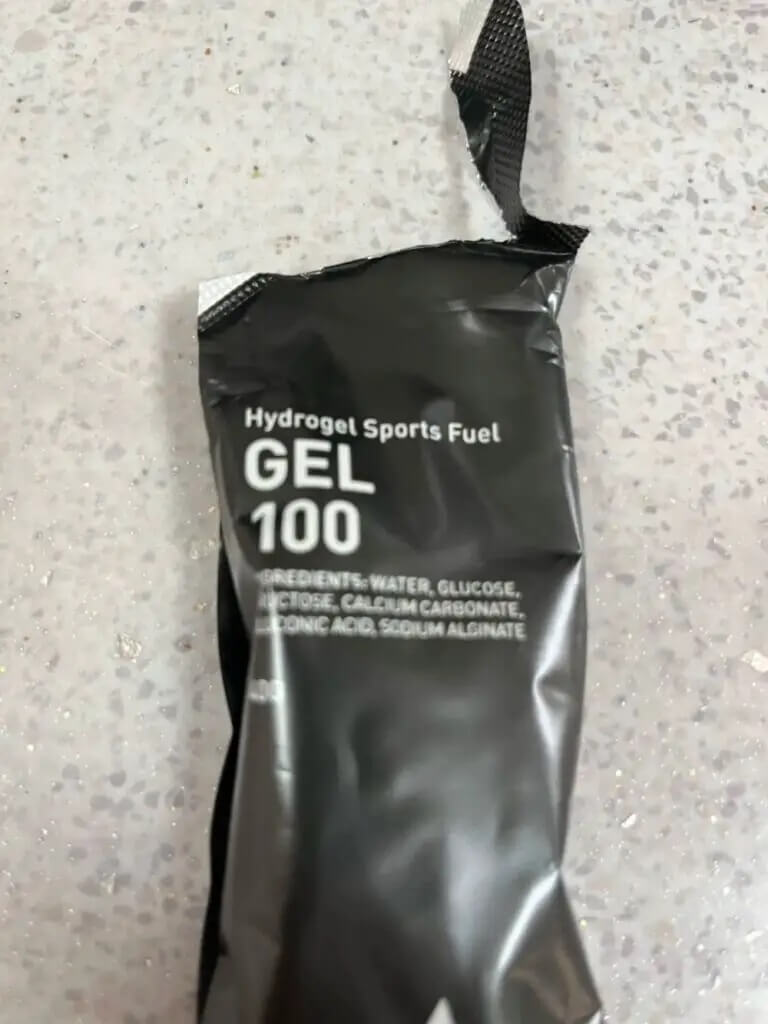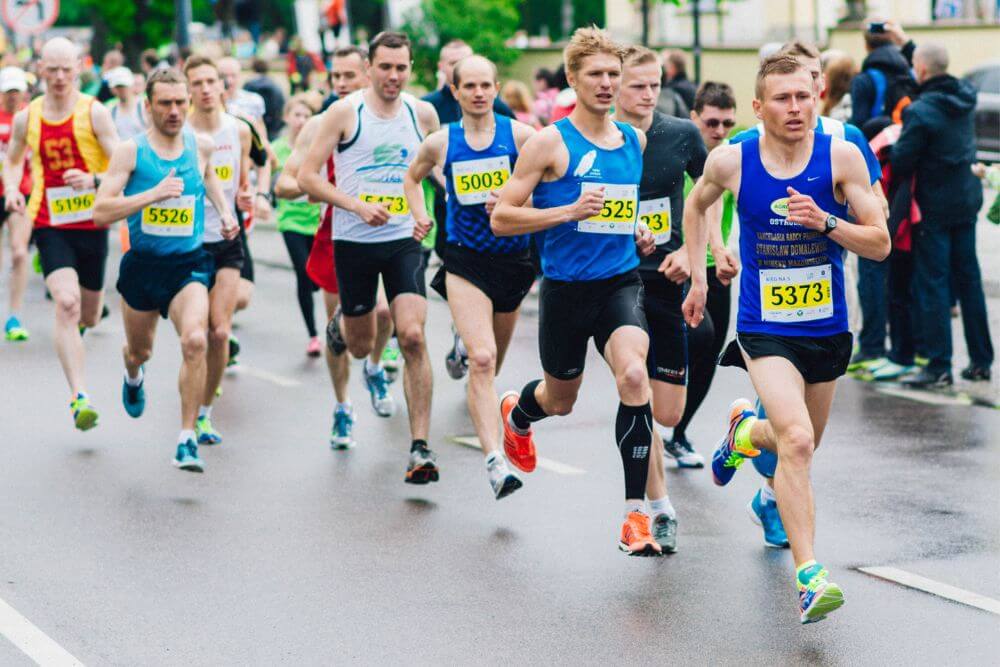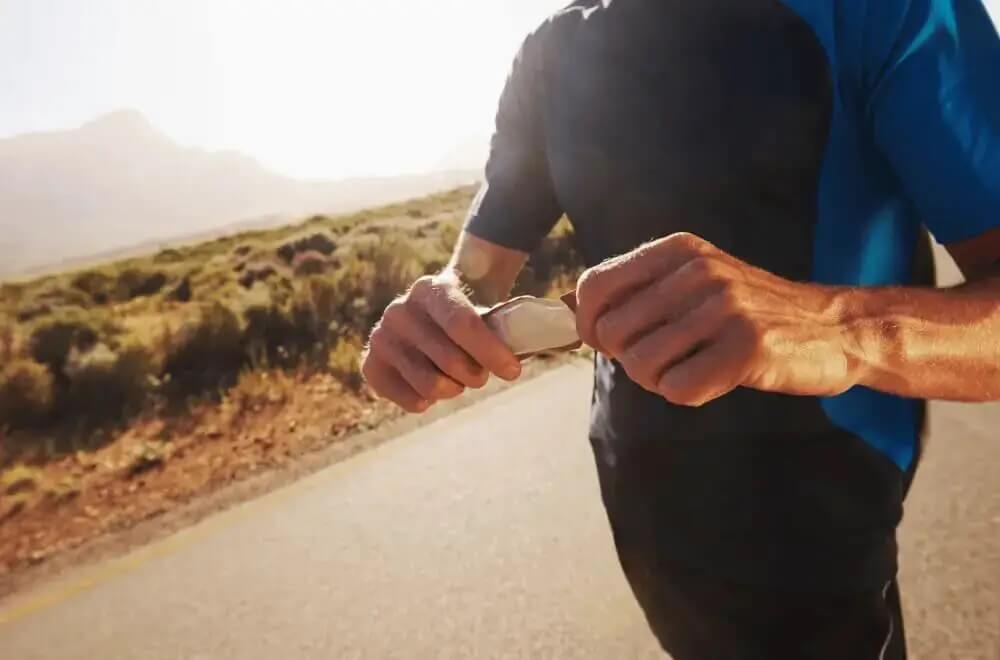Are you wondering when to take energy gels during a marathon? In this article, our marathon runner investigates.
Energy gels are an essential component of marathon runners’ nutrition plans, offering a quick and convenient source of easily digestible carbohydrates. They can help maintain energy levels and prevent the dreaded “wall” when taken at the right intervals. But how often should you consume them during a marathon to optimize your performance and knock out that personal best?
I’ve experimented with multiple fueling strategies and energy gels while competing in various big-city marathons. It’s tricky to find the sweet spot between over-fueling and underfueling, and I’d recommend any new marathon runner practice the advice in training first.
While individual tolerance and preferences may vary, a general guideline suggests consuming one energy gel every 30-40 minutes. It’s also recommended to start taking gels around 45-60 minutes into the race, depending on your reaction to gels in training. Keep in mind that it’s crucial to adjust the frequency according to your comfort and needs during the race.
Contents
Understanding Energy Gels

Energy gels are designed to help runners maintain their energy levels during endurance events like marathons. They contain a concentrated source of carbohydrates to provide quick, easily-digestible fuel for your muscles.
Benefits of Energy Gels

The latest gels can feel like pressing a go-faster button when you’re about to hit the wall or run out of gas. There are several advantages to using energy gels during a marathon:
- Fast-digesting carbohydrates: Energy gels provide a quick source of glucose that your body can easily break down and convert to energy.
- Convenience: Energy gels are portable, easy to carry, and simple to consume while running.
- Reduced risk of hitting the wall: Using energy gels can help prevent the depletion of glycogen stores in your muscles, reducing the chances of “hitting the wall” during a marathon.
It is important to note that energy gels should be taken with water to aid digestion and absorption. I’d avoid consuming these gels with sports drinks. I did this one year and it triggered stomach issues and a headache.
Choosing the Right Energy Gel
When selecting an energy gel for your marathon, consider the following factors:
| Carbohydrate Content | Look for gels with high carbohydrate and fructose/glucose contents to provide a steady source of energy for your muscles, ideally above 25 grams. |
| Timing | Take an energy gel before or at the start line and then every 20-30 minutes during the race. Sip water to wash it down. |
| Personal Preferences | Individual runners may react differently to specific energy gels, so consider testing various brands and formulas during your training runs to find the best one for you. |
Energy gels can offer multiple benefits for marathon runners, but it is crucial to find the right gel and timing strategy tailored to your individual needs and preferences. Maurten gels are particularly popular and Eliud Kipchoge regularly uses them for his racing strategy.
Timing Your Energy Gel Intake
Pre-Marathon Preparation
Experimenting with energy gels during your training runs is essential for finding the right dosage and frequency for your individual needs. Most marathon runners take a gel or energy drink half an hour before the race, and often with caffeine. You might be interested in learning why is a marathon 26.2 miles.
During the Marathon
Consistency is key when it comes to fueling during a marathon. To avoid hitting the dreaded “wall,” remember to take your energy gels before you need them, not as you feel your energy levels waning.
Begin by taking an energy gel around the three or four-mile mark or after 25 minutes of running. Some runners like to fuel based on how they feel but I prefer taking gels every 25 minutes thereafter, i.e., being consistent. To find an ideal approach, practice with energy gels in advance will help you understand how your body reacts and ensure a smooth race day experience.
When I raced the New York Marathon, I took a Maurten gel every three to four miles. I alternated between caffeine and caffeine-free gels. However, I practiced this marathon fueling strategy in training. For more, read our Maurten gels review.
Post-Marathon Recovery
After crossing the finish line, your body needs replenishment to kick-start the recovery process. While energy gels are primarily used for maintaining energy levels during the race, consider consuming a recovery snack or drink within 30 minutes of finishing.
This will help restore glycogen stores, repair muscle tissue, and rehydrate your body. Choose foods and beverages that balance carbohydrates, protein, and electrolytes for optimal recovery. I never consume gels after a race, preferring natural or real carbs. They are also hard to stomach after 26.2 miles!
Factors to Consider
When deciding how frequently to take energy gels during a marathon, consider factors related to optimal timing, frequency of gel consumption, and environmental conditions.
Individual Tolerance
Every runner has a unique digestive system and carbohydrate tolerance. The ideal frequency of taking energy gels can vary considerably from person to person. Some runners might be able to take a gel every half hour. However, others may require a higher or lower frequency depending on their individual needs.
Experiment with different energy gels and their consumption frequency during training runs before race day. This will help you determine the optimal timing and quantity of gels that suit your body the best, minimizing any discomfort or risk of gastrointestinal distress during the marathon.
Environmental Conditions
Factors such as temperature, humidity, and altitude can influence how much energy and hydration your body needs.
In hotter or more humid conditions, your body may require more frequent consumption of energy gels to maintain optimal performance. On the other hand, when running in cooler or more moderate conditions, you might find that your body can sustain performance with a lower frequency of energy gel intake.
Adjust your energy gel consumption plan based on the environmental conditions on race day. This will ensure that your body receives the appropriate amount of energy needed to perform at its best throughout the marathon. Remember, the latest gels also contain electrolytes making them ideal for fueling if you sweat a lot.
Alternative Fuelling Options
While energy gels are a popular choice for marathon runners, other whole food alternatives can provide the necessary energy boosts during long runs. Below are a few options that you can consider.
- Raisins: A natural and healthy alternative, raisins have been found to be an effective energy source for runners.
- Bananas: Easy to digest and rich in potassium, bananas make for a great on-the-go snack for runners.
- Dried Fruits: Dried fruits like apricots, dates, and figs, are packed with natural sugars and are a great alternative to processed energy gels.
Some runners opt for energy chews, drinks, or even natural sources like honey, as mentioned on VeloForte. These options can help diversify your energy sources and prevent palate fatigue during long runs.
It’s essential to experiment with these alternatives during training to find out which option works best for you. Test different foods to determine their effectiveness and to ensure your stomach can handle them during a race.
Fueling for Marathon Energy Gels

Energy gels can be an essential tool for marathon runners to maintain their energy levels throughout 26.2 miles. It’s crucial to find a personalized gel consumption strategy that works for each marathon runner based on their needs and preferences. Marathon runners often follow self-identified energy gel consumption strategies which optimize their performance during the race.
Energy gels are especially beneficial in endurance sports like marathon running and long-distance cycling. However, it’s important to remember that hydration also plays a major role in maintaining performance. While consuming energy gels, it’s a good idea to drink water in moderate amounts to prevent the excessive need to urinate, as this can impact finishing time.
I made this mistake one year and narrowly missed out on a personal best due to an unplanned toilet break!
Ultimately, the most important aspect of using energy gels is balancing consuming enough energy to sustain yourself during the marathon and preventing any gastrointestinal discomfort or other issues. Experimenting with various gels and consumption timings during training will help runners achieve the perfect balance during their marathon races.
For more, read our guide about when to take energy gels during a half marathon.
This article was researched with the help of ChatGPT. It was then edited, fact-checked, and rewritten by a marathon runner.



